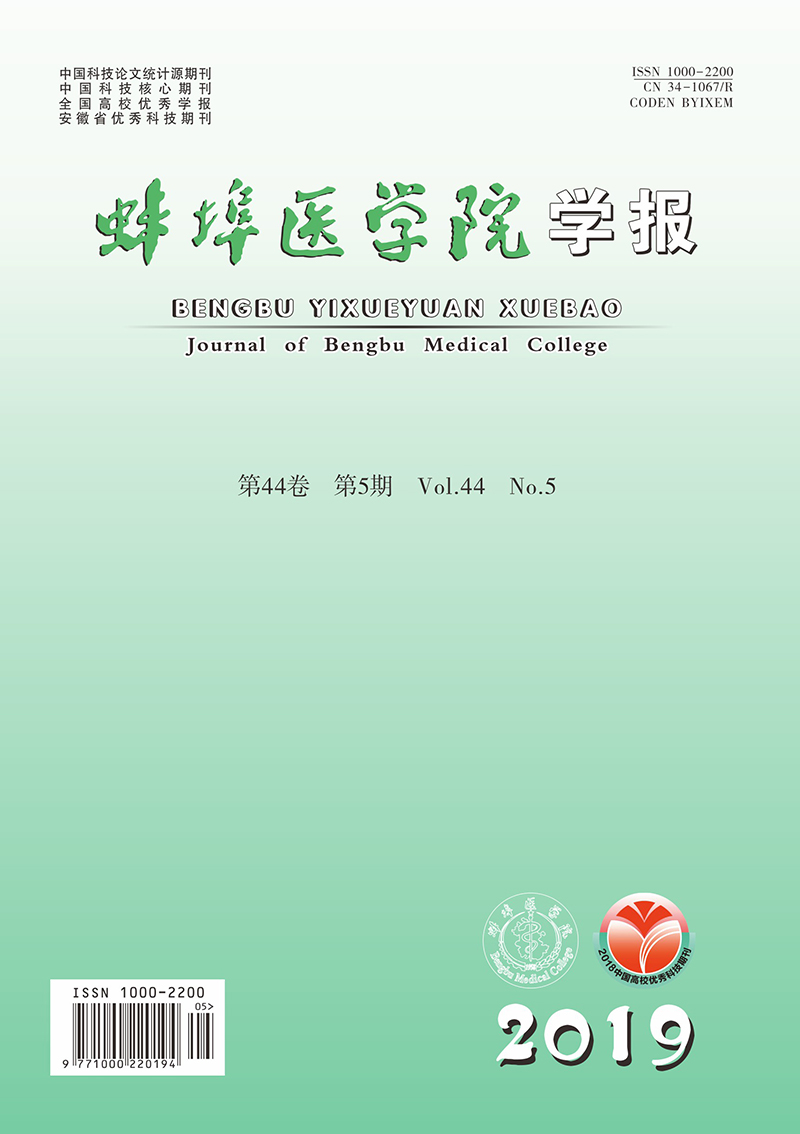-
早期复极(early repolarization,ER)与特发性室性心动过速/心室颤动、心源性猝死密切相关,严重时可引起病人死亡。早期复极图形(early repolarization pattern,ERP)仍是目前心血管病领域研究的重要课题,已有研究探讨ERP与严重室性心律失常、心源性猝死的发生机制,尤其是ERP预测心源性猝死、离子流机制等方面[1]。有研究[2]认为,ER联合ST段抬高程度和J波振幅等参数对预测高危心源性猝死病人具有重要的价值。既往观点[3-4]认为,将ER阐述为QRS波终末切迹或顿挫,且与ST段、J点抬高程度及形态等方面以初步判断ER的良恶性。但目前有关QRS波群对急性前壁心肌梗死病人心源性猝死风险预测价值的研究报道较为少见。为此,本研究将本院收治的98例急性前壁心肌梗死病人作为研究对象,研究病人心电图(electrocardiogram,ECG)的QRS波群的特点、表现,旨在探讨QRS波群对急性前壁心肌梗死病人心源性猝死风险的预测价值,进而为临床应用提供一定的依据。
HTML
-
将本院2015年1月至2017年6月收治的98例急性前壁心肌梗死病人作为研究对象,纳入标准:(1)冠状动脉造影检查发现前降支为罪犯冠脉;(2)后降支、右冠状动脉未出现完全闭塞;(3)无肺部疾病、吸毒等导致J波改变的其他因素。排除标准:(1)QRS时限≥120 ms,伴有起搏心律、心房扑动/颤动者;(2)因室间隔肥厚或缺损、肺动脉栓塞、限制性肥厚型心肌病、三环抑制剂中毒、末梢或中枢神经系统异常、房室传导障碍等造成J波改变的因素;(3)伴有代谢或电解质紊乱、缺血性心肌病、Brugada综合征、心包炎、恶性肿瘤、肝肾功能异常、精神性疾病等病史;(4)ECG模糊、图形质量欠佳;(5)临床资料不全。按照ECG ER结果分为阴性组和阳性组各49例。本研究已通过本院医学伦理委员会批准。
-
3个及以上相邻ECG发生以下变化:(1)J点抬高的形态表现为仅J点抬高或QRS波终末顿挫、切迹;(2)J点抬高幅度>0.1 mV;(3)J点后ST段呈现水平型抬高或未抬高。
-
病人同步12导联ECG,振幅标准10 mm/mV,走纸速度25 mm/s,频率120 Hz。采用美国GE公司MAC5500型ECG仪,由本院两名心血管内科医生描记,心电信息均在MUSE系统上进行处理,并由系统自动运算。
-
(1) 收集病人的临床资料,包括性别、年龄、体质量指数(body mass index,BMI)、吸烟史、基础性疾病(糖尿病、高血脂症、高血压史)、冠状动脉病变数(单支、多支)、冠状动脉开通时间。(2)记录病人QRS时限、QT间期、QTc间期、PR间期、心率(heart rate,HR)、左心室射血分数(left ventricular ejection fraction,LVEF)、血钾、三酰甘油(triglyceride,TG)等参数。(3)分析病人ERP特点、形态等,记录2组病人心室颤动、室性心动过速和死亡等发生率。
-
采用t检验和χ2检验。
1.1. 一般资料
1.2. ER诊断标准[5]
1.3. 方法
1.4. 观察指标
1.5. 统计学方法
-
2组病人性别、年龄、吸烟史、基础性疾病(糖尿病、高血脂症、高血压史)、冠状动脉开通时间及LVEF等资料比较差异均无统计学意义(P>0.05);但阳性组TG、血钾水平较阴性组明显升高(P < 0.01),心室颤动、室性心动过速和死亡率较阴性组亦明显升高(P < 0.01)(见表 1)。
项目 阴性组(n=49) 阳性组(n=49) χ2 P 男/女 31/18 27/22 0.68 >0.05 年龄/岁 57.97±5.35 59.01±4.27 1.06* >0.05 BMI/(kg/m2) 24.61±2.99 25.57±3.12 1.56* >0.05 吸烟史 29(59.18) 32(65.31) 0.39 >0.05 糖尿病史 12(24.49) 15(30.61) 0.46 >0.05 高血压史 26(53.06) 24(48.98) 0.16 >0.05 高血脂症史 11(22.45) 10(20.41) 0.06 >0.05 LVEF/% 46.24±7.64 48.79±6.90 1.73* >0.05 TG/(mg/dL) 1.31±0.91 1.85±0.47 3.69* < 0.01 血钾/(mmol/L) 4.05±0.52 4.78±1.36 3.51* < 0.01 冠状动脉病变数 单支 25(51.02) 23(46.94) 0.16 >0.05 多支 24(48.98) 26(53.06) 冠状动脉开通时间/h 6.95±2.01 7.79±2.32 1.92* >0.05 室性心动过速 1(2.04) 17(34.69) 17.42 < 0.01 心室颤动 1(2.04) 18(36.73) 18.67 < 0.01 死亡 0 16(32.65) 19.12 < 0.01 *示t值 -
阳性组QRS时限较阴性组明显延长(P < 0.01),HR较阴性组明显减慢(P < 0.01),QTc间期较阴性组缩短(P < 0.01);但2组病人QT间期和PR间期差异均无统计学意义(P>0.05)(见表 2)。
分组 n QRS时限/min HR/(次/分) QTc间期/ms QT间期/ms PR间期/ms 阴性组 49 89.07±7.93 77.98±6.90 459.04±31.24 401.45±49.79 161.90±25.16 阳性组 49 97.96±7.23 68.05±10.32 424.05±39.68 405.02±51.22 160.05±26.52 t — 5.80 5.60* 4.85 0.35 0.35 P — < 0.01 < 0.01 < 0.01 >0.05 >0.05 *示t′值 -
阳性组病人ERP导联分布多处于下壁(27例,55.10%)、下壁+胸前导联(16例,32.65%),而少数为侧壁+胸前导联(4例)、侧壁(2例);ERP以切迹(24例,48.98%)为主要表现,其次是顿挫型(20例,40.81%),而少数为顿挫和切迹混合型(2例)和J点抬高型(其中抬高>0.2 mV者1例,抬高0.1~0.2 mV者2例);ST段多为水平型抬高(46例,93.88%),少数为上斜型抬高(3例)。
2.1. 临床基本资料的比较
2.2. 2组病人ECG参数的比较
2.3. 阳性组病人ERP形态和特点
-
既往对ER的定义是ST段、J波抬高,严重心肌缺血引起缺血性J波,多数病人早期仅为缺血性J波,后期可具有典型心肌梗死的表现[6]。缺血性J波的出现可早于急性心肌梗死,亦可在急性心肌梗死时出现,容易引起恶性室性心律失常,并且其影响机制的病理基础与2相折返相同[7-8]。所以,ER的ECG变化可用于早期诊断急性心肌梗死,其在疾病超早期的图形特点和ECG特征对早期诊治急性心肌梗死有着良好的临床价值。
有研究[9]认为,合并ER的心肌梗死病人窦性心律较无ER者明显降低。并且,有研究表明[10],伴有ER的心血管疾病者HR较无ER者明显减慢。此外,有研究[11]报道,下壁和/或胸前导联J波者HR较无J波者明显减缓。本研究发现,阳性组TG、血钾水平较阴性组明显升高,心室颤动、室性心动过速和死亡率较阴性组亦显著升高。QT间期是指QRS波群起点至T波终点的长度,由ST段、QRS波群和T波组成,其可用于反映心室的去极化-复极化的总体过程,并且其与心室心肌细胞动作电位存在显著关系,特别是2、3相的电流改变。QTc间期是依据HR利用Bazzett公式所调整而出的QT间期,其在临床中的应用价值较QT间期高。阳性组QRS时限较阴性组明显延长,HR较阴性组明显减慢,QTc间期较阴性组缩短;但2组病人QT间期和PR间期的比较,均无明显差异。结果表明,ER者心室复极出现异常,使得发生心室颤动、室性心动过速的风险明显提高。结果提示,分析ERP的形态和特点对评估急性前壁心肌梗死病人心源性猝死风险具有一定的预测价值,其中ER可作为引起急性前壁心肌梗死病人死亡风险的危险因素。目前,对ER的发病机制尚未明确,而J波产生的离子流机制可能是因瞬时外向钾电流提高,使得复极离散度、内外膜电位差升高,进而引起折返,最终引起恶性室性心律失常、猝死。
有研究[12]表明,ECG伴有ST段水平型抬高和下壁导联J点抬高振幅≥0.2 mV是引起特发性心室颤动的影响因素。另有研究[13]报道,中年男性伴有下壁导联J点抬高振幅≥0.2 mV引起猝死的风险明显提高,若在此基础上伴有ST段水平型抬高可使猝死发生的概率提高3~4倍,其心室颤动出现前QRS波终末切迹或顿挫振幅提高。已有研究[14-15]指出,ST段水平型抬高与心室颤动的发生密切相关。本研究中,阳性组病人ERP导联分布多处于下壁(55.10%)、下壁+胸前导联(32.65%),而少数为侧壁+胸前导联、侧壁;ERP以切迹为主要表现,其次是顿挫型,而少数为顿挫和切迹混合型和J点抬高型(其中抬高>0.2 mV者1例,抬高0.1~0.2 mV者2例);ST段多为水平型抬高,少数为上斜型抬高。结果表明,急性前壁心肌梗死病人ERP的导联分布多为下壁、下壁+胸前导联,而侧壁+胸前导联、侧壁所占比例较少。其次,急性前壁心肌梗死病人ER形态多为切迹型或顿挫型。ER有着慢频率依赖的特点,可由此判断其与心肌缺血导致的ST段抬高有关,并且可采用24 h动态ECG对病人HR升高后ST段的变化情况进行观察。
综上所述,相比无ER的急性前壁心肌梗死病人,伴有ER者ECG QRS时限延长、QTc间期缩短、HR减缓,心室颤动、室性心动过速的发生率明显升高,且发生死亡的风险明显提高。






 DownLoad:
DownLoad: